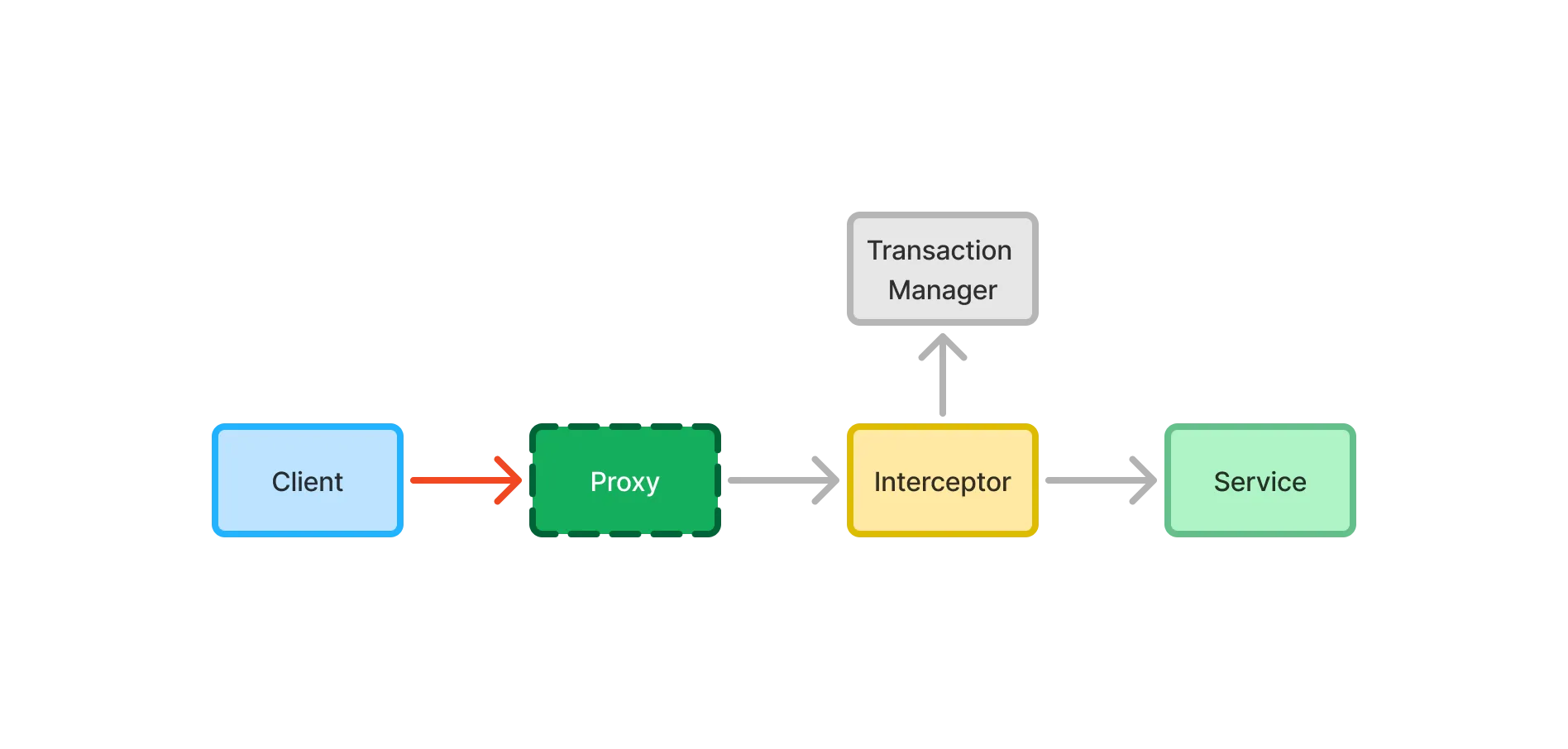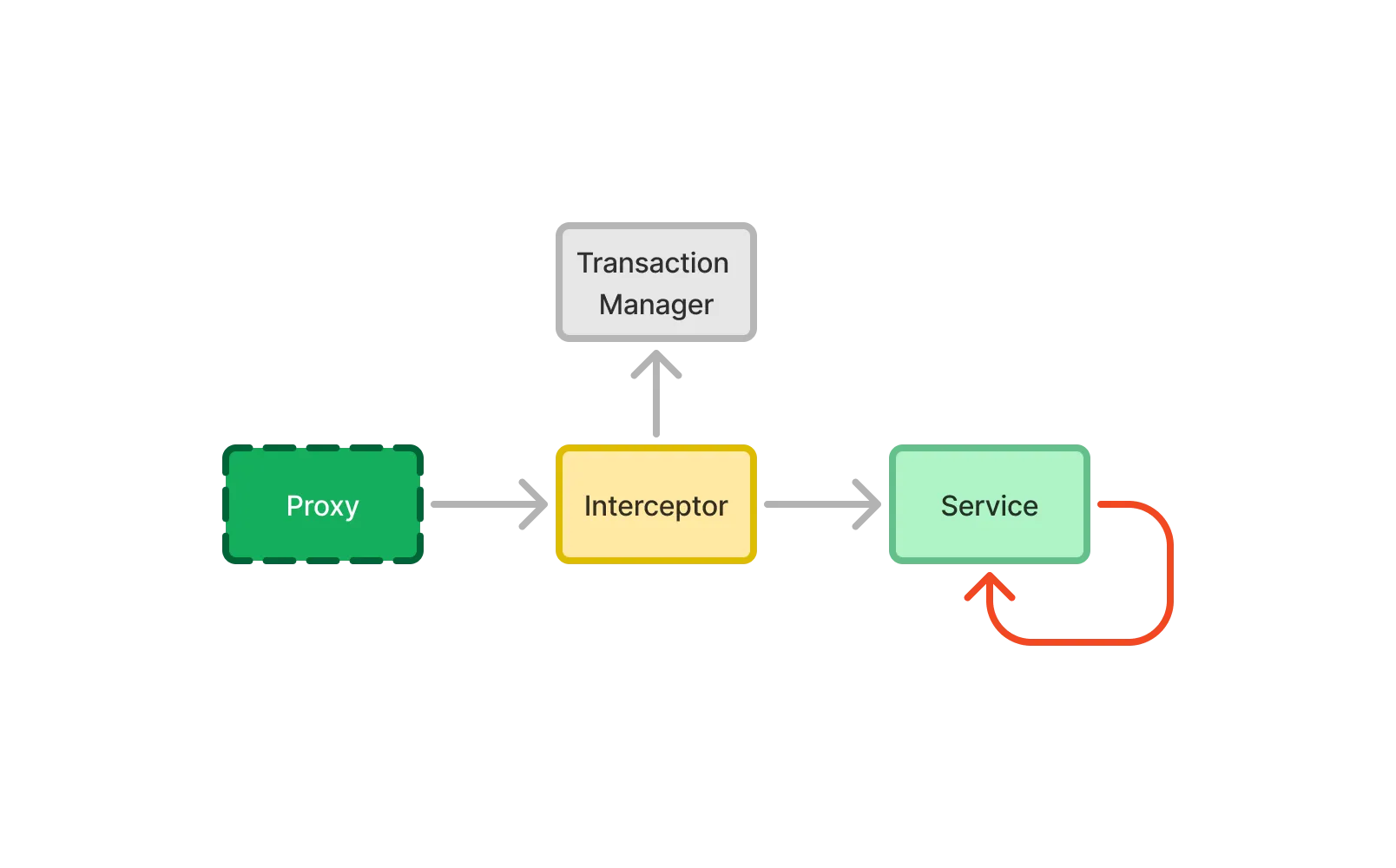Declarative Transactions
The easiest way to manage transactions in a Spring application is by using the @Transactional annotation. You can place it directly on your class, or on individual methods. Don’t use the annotation on interfaces, except for Spring Data repositories.
The following example instructs Spring to run all methods of the application service inside a new transaction:
import org.springframework.transaction.annotation.Propagation;
import org.springframework.transaction.annotation.Transactional;
@Service
@Transactional(propagation = Propagation.REQUIRES_NEW)
public class MyApplicationService {
...
}If you use @Transactional on both the class and individual methods, the method level annotation takes precedence. The following example tells Spring to use the REQUIRED (the default) propagation level for all application service methods, except for myMethod() that should use SUPPORTS:
import org.springframework.transaction.annotation.Propagation;
import org.springframework.transaction.annotation.Transactional;
@Service
@Transactional
public class MyApplicationService {
...
@Transactional(propagation = Propagation.SUPPORTS)
public void myMethod() {
...
}
}|
Important
|
In earlier versions of Spring, you could only use @Transactional on public methods. As of Spring version 6.0, you can also use it on protected and package-visible methods if you’re using class-based proxies. For interface-based proxies, the methods must always be public, and defined in the proxied interface. Always make your transactional methods public.
|
For more information about declarative transaction management, see the Spring Documentation.
Committing
You don’t have to do anything special to commit a transaction. Spring commits the transaction after the method returns, unless it has been marked for rollback. This is described in the following section.
Rolling Back
You mark the transaction for rollback by throwing an unchecked exception. The following example causes Spring to rollback the transaction if validation fails:
@Service
public class MyApplicationService {
...
@Transactional
public void myMethod(MyInput input) {
if (!isValid(input)) {
throw new IllegalArgumentExcpetion("Bad input");
}
...
}
}A checked exception doesn’t cause the transaction to rollback by default. You can override this, though, by using the rollbackFor annotation attribute. The following example instructs Spring to rollback the transaction if myMethod throws a MyCheckedException:
@Service
public class MyApplicationService {
...
@Transactional(rollbackFor = MyCheckedException.class)
public void myMethod() throws MyCheckedException {
...
}
}Isolation Level
You can use the @Transactional annotation to specify the isolation level of the transaction. By default, it uses the database implementation’s own default transaction level. The following example has Spring execute myMethod() using the read uncommitted isolation level:
import org.springframework.transaction.annotation.Isolation;
import org.springframework.transaction.annotation.Transactional;
@Service
public class MyApplicationService {
...
@Transactional(isolation = Isolation.READ_UNCOMMITTED)
public void myMethod() {
...
}
}Caveats
When working with declarative transactions, it’s important to remember that the annotations themselves don’t manage any transactions. They’re merely instructions for how Spring should manage the transactions.
During application startup, Spring detects the @Transactional annotation and turns the service into a proxy. When a client calls the proxy, the call is routed through a method interceptor. The interceptor starts the transaction, calls the actual method, and then commits the transaction when the method returns, as illustrated in this diagram:

The @Transactional annotation is ignored if a service calls itself. This happens because the call doesn’t go via the proxy, as illustrated in the following diagram:

In the following example, myFirstMethod() executes inside its own transaction if a client calls it, directly. However, if a client calls mySecondMethod(), myFirstMethod() executes inside the transaction of mySecondMethod() despite being annotated differently:
@Service
public class MyApplicationService {
@Transactional(propagation = REQUIRES_NEW)
public void myFirstMethod() {
}
@Transactional
public void mySecondMethod() {
// myFirstMethod() will participate in the transaction of mySecondMethod(),
// even though it has been annotated as REQUIRES_NEW.
myFirstMethod();
}
}You can fix this by managing the transactions, programmatically.